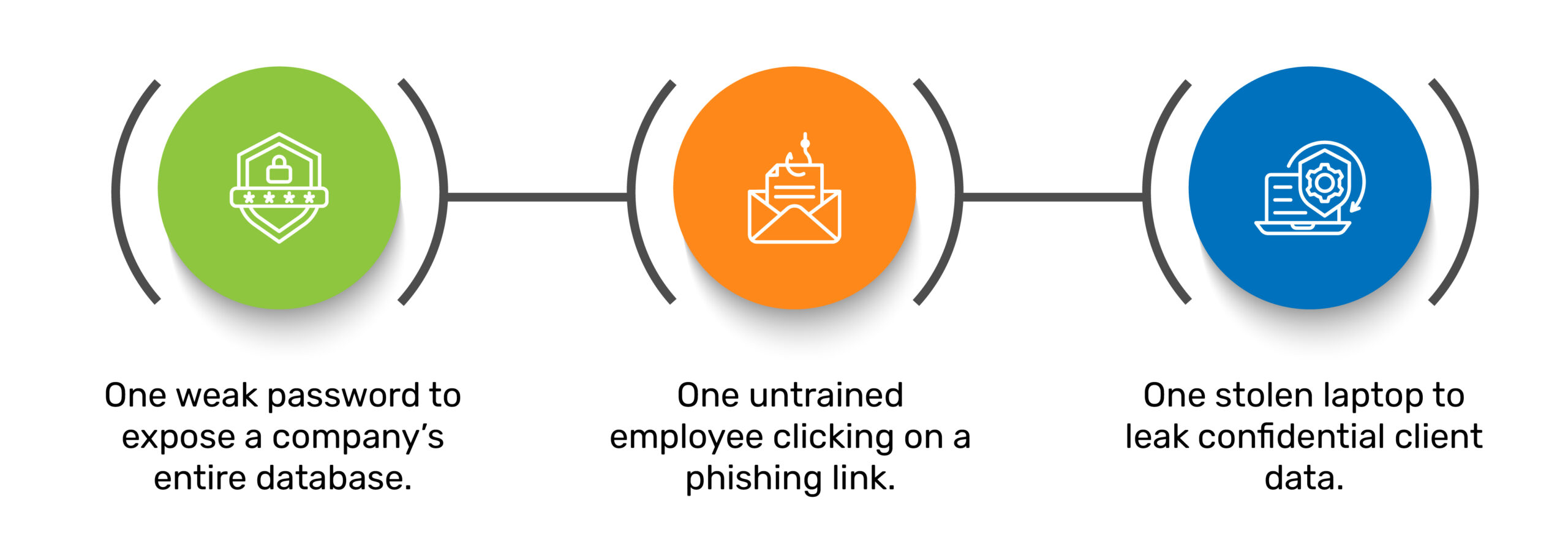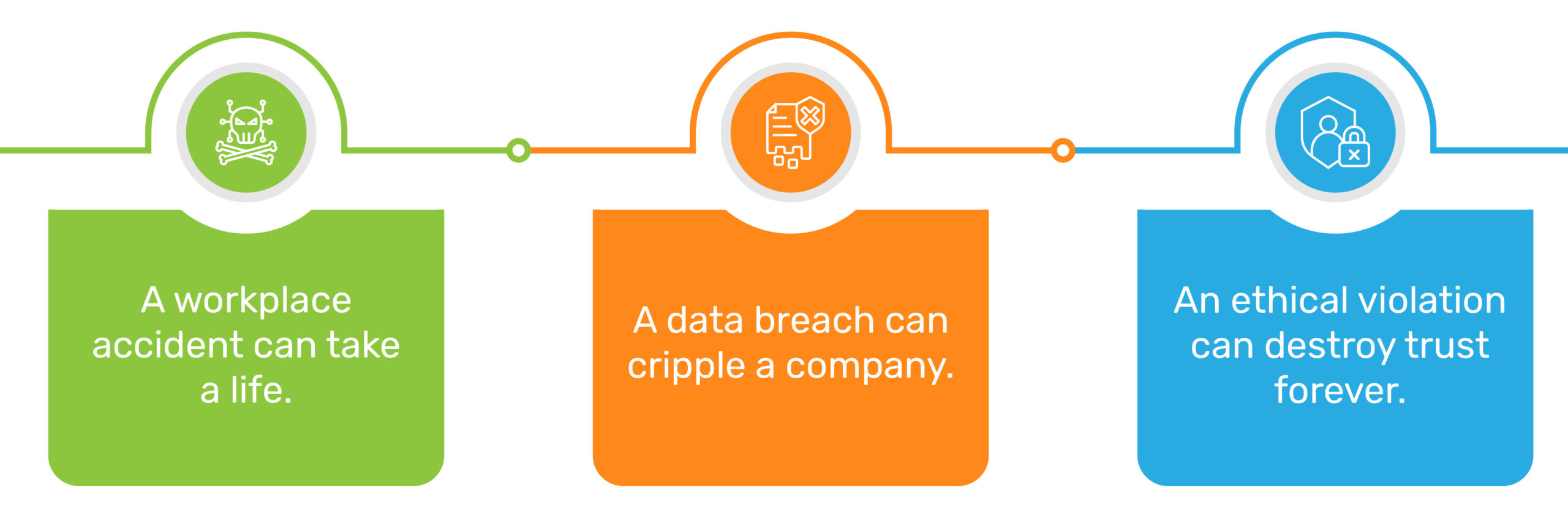Trust holds organizations together. It’s built when safety protocols are followed, data is protected, and concerns are handled with care. These actions shape how people work, how teams interact, and how leaders create a stable environment.
That trust can weaken when compliance is not maintained. A missed safety check, a poor data safeguard, or an unresolved complaint can lead to real consequences. Workflows are interrupted, people feel uncertain, and reputations are placed under pressure. Recovery often takes more time and resources than prevention would have.
Compliance issues rarely begin with a major event. They often start with small gaps that go unnoticed until they affect day-to-day operations. Staying on track means putting systems in place that support consistency, accountability, and clear communication.
Here are three common compliance challenges and how organizations can take practical steps to prevent them.
The Risks of Overlooking Workplace Safety
Imagine waking up for work, saying goodbye to your family, and never making it back home. It’s a heartbreaking reality for thousands of workers every year. In 2022 alone, more than 5,400 people lost their lives on the job. Many of these deaths could have been prevented with proper safety protocols.
However, workplace injuries don’t just affect individuals. They take an emotional and financial toll on families, co-workers, and entire businesses. When safety isn’t prioritized, accidents happen, and they bring:
- Pain and suffering: A single fall, a chemical exposure, or a machine malfunction can cause life-altering injuries.
- Lost jobs and income: Injured employees may struggle to return to work, while organizations face costly compensation claims.
- Legal battles: A single workplace violation can cost thousands in OSHA fines, lawsuits, and settlements.
Common Safety Risks That Are Often Ignored
- Lack of safety training: Employees handling hazardous equipment without proper guidance.
- No protective gear: Workers exposed to harmful substances without gloves, masks, or goggles.
- Unclear emergency plans: Fire drills and evacuation procedures that exist on paper but not in practice.
- Overlooking mental well-being: Stress and exhaustion leading to mistakes that put lives at risk.
A Commitment to Safety Saves Lives
A culture of safety doesn’t just happen—it’s built through consistent training, clear policies, and leadership that prioritizes employee well-being. Every business has a choice: invest in prevention or deal with the aftermath of a preventable tragedy.
A Single Click Can Lead to a Massive Data Breach
We trust businesses with our personal information every day—our addresses, credit card numbers, even medical records. But what happens when that data ends up in the wrong hands?
Cybercriminals don’t break into buildings; they break into unprotected systems, and all it takes is:

The impact goes beyond financial loss. In 2024, the average data breach cost businesses $4.88 million, but the bigger issue is trust. When personal information is exposed, customers, clients, and employees lose confidence in an organization’s ability to keep their data safe. And once trust is broken, rebuilding it is difficult.
How Cybersecurity Gaps Put Organizations at Risk
- Untrained employees falling for phishing scams: Many cyberattacks start with an innocent-looking email.
- Weak security policies: Outdated systems, unencrypted files, and shared passwords create easy entry points.
- Failure to comply with privacy laws: Violations of GDPR, HIPAA, and other regulations lead to massive legal fines.
Data Protection Starts with Awareness
Organizations spend millions on cybersecurity software, but the truth is that people are the first line of defense. Training employees on cybersecurity best practices—how to recognize scams, create strong passwords, and securely handle data—can prevent costly breaches before they happen.
Ethical Violations: The Damage You Can’t See Right Away
Not all compliance failures make headlines. Some of the most damaging violations occur unnoticed, fostering toxic workplace cultures behind closed doors.
What happens when employees don’t feel safe speaking up?
- Harassment goes unreported.
- Discrimination is ignored.
- Whistleblowers are punished instead of protected.
Over time, these issues erode trust, damage morale, and push good employees out the door. Worse, when unethical behavior is exposed, it can destroy an organization’s reputation overnight.
Real-World Consequences of Ethical Failures
- High turnover: A toxic work culture can result in substantial employee turnover. The Society for Human Resource Management (SHRM) reports that one in five American employees left their jobs in the past five years due to a bad organizational culture, costing businesses approximately $223 billion during this period.
- Lawsuits and financial penalties: Organizations that ignore workplace harassment or discrimination claims can face massive legal consequences.
- Reputation damage: Once an organization is known for mistreating employees, attracting top talent becomes nearly impossible.
Building a Culture of Ethics and Accountability
Ethical compliance isn’t just about following laws—it’s about fostering a workplace where respect, fairness, and integrity are non-negotiable. That starts with leadership setting the tone and ongoing training to ensure that every employee understands their rights and responsibilities.
The Cost of Ignoring Compliance: It’s Never “Just a Small Risk”
The hard truth? Businesses don’t get second chances after a major compliance failure.

And the worst part? Most compliance failures are preventable. So the real question is: Why wait for something to go wrong?
Organizations that invest in compliance training aren’t just avoiding lawsuits and fines—they’re protecting their people, safeguarding their reputation, and securing their future.
KnowledgeCity makes it easy to stay ahead of risks and build a stronger, more resilient workforce. From soft skills to safety and compliance, our training keeps your team prepared, confident, and always compliant.
Book a demo today and take the first step toward a safer, smarter workplace.
Subscribe to Our Newsletter
Join 80,000+ Fellow HR Professionals. Get expert recruiting and training tips straight
to your inbox, and become a better HR manager.

 KnowledgeCity
KnowledgeCity 











